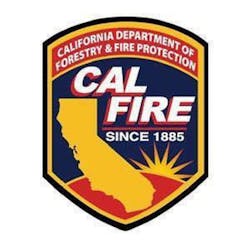CA Budget Includes Hiring Nearly 700 Full-Time FFs
The past three years — with massive wildfires setting records across California — have been rough on firefighters.
Now, as climate change continues to warm the state and population growth pushes more people into fire-prone areas, some relief may be on the way.
The state budget that Gov. Gavin Newsom proposed Friday calls for hiring 677 new full-time staff members at CAL FIRE, the state’s lead firefighting agency, over the next five years. That’s an increase of 10.7% from the current total of 6,280 full-time employees who work at the agency now. Another 2,385 CAL FIRE positions are seasonal employees.
Of those new full-time hires, 438 would be front-line firefighters, and the other 239 would work in other jobs, such as firefighter training centers, equipment maintenance and administrative support.
State leaders say the staffing boost, which is expected to be approved by the Democratic-controlled Legislature later this year, is a way to bring in reinforcements after a grueling marathon of firefighting that worsened amid California’s 2012-16 drought.
“The men and women who have been in the front lines of fighting fires for the last three years have performed heroically,” said Wade Crowfoot, California’s Secretary of Natural Resources.
“But additional personnel will be needed to ensure those firefighters have the backup they need to have adequate rest, whether they are injured or fatigued,” he said. “We have been taxing our firefighters pretty significantly in recent years.”
California’s 2020-21 budget has a $5.6 billion surplus, which makes the firefighting expansion easier to fund.
There’s no question wildfires have been near the top of California’s concerns in recent years. Since modern record-keeping began in 1932, four of the five largest fires in California history have happened since 2012.
Two years ago, the Camp Fire in Butte County leveled the town of Paradise, killing 86 people — making it the deadliest wildfire anywhere in the United States in 100 years, when sparks from a steam locomotive set off blazes in Northern Minnesota in 1918 that killed 453 people in rural towns near Duluth.
That disaster in Paradise followed the Wine Country fires of 2017, which killed 44 people, destroyed 8,900 structures and caused $14 billion in damage across Napa, Sonoma and Mendocino counties.
The blazes, some of which were caused by PG&E power lines that fell during windy days, piled up more than $30 billion in liability for the utility, sending it into bankruptcy.
The 2019 fire season was far milder than 2017 and 2018. That was due partly to a wet winter last year; power shutoffs by PG&E and other utilities during the hottest, windiest days in the fall; and efforts by fire crews to get ahead of large fires by pre-positioning engines and other equipment in areas most at risk.
The bigger Cal Fire staffing levels will allow for more pre-positioning in the coming years, Crowfoot said, a tactic that was credited with saving Windsor and other North Bay towns during last fall’s 77,758-acre Kincade Fire in Sonoma County.
But as more than 15 million acres in Australia are burning now, and massive fires charred the Amazon rainforest and Siberia in the past two years, California officials say it’s only a matter of time before the Golden State faces extreme risk again.
Last year, Newsom and state lawmakers increased the number of Cal Fire fire engines and funded hundreds of fire-spotting cameras around the state. They increased forest thinning projects, one of which is visible along Highway 17 between Summit Road and Los Gatos in Santa Clara County.
Friday’s 2020-21 proposed budget also contains other new firefighting measures. Among them, $80 million for an aerial laser system, called LiDAR, which will allow detailed 3-D maps to be created showing where the most dead trees are around the state, and more accurately pinpointing fires and firefighting terrain.
The budget also includes $9 million to begin planning for a “Wildfire Forecast and Threat Intelligence Integration Center” in Sacramento. The new center, to be housed at the Office of Emergency Services, would closely track fire weather, and the spread of existing blazes, as well as generating information for local communities to reduce fire risk.
The budget also includes $110 million for Cal Fire and the state Office of Emergency Services to set up a pilot program to harden hospitals, fairgrounds used as evacuation shelters, and rural homes from fire risk, and another $8 million for Cal Fire to expand its defensible space inspections around homes.
Lawmakers, particularly those in areas that have suffered massive fires recently, generally praised the new strategy, but noted the problem is massive and will require years of work.
“All these are good steps,” Assemblyman Jim Gallagher, a Republican whose district includes the town of Paradise, told the Associated Press. “But we need to do even more if we want to get on top of the problem quicker.”
———
©2020 the San Jose Mercury News (San Jose, Calif.)
Visit the San Jose Mercury News (San Jose, Calif.) at www.mercurynews.com
Distributed by Tribune Content Agency, LLC.
